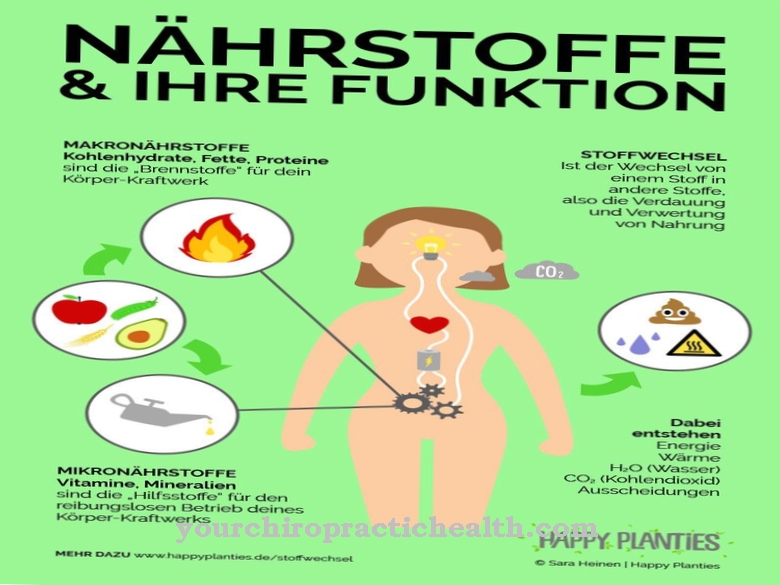pepsin is the main digestive enzyme in the stomach. With its help, the food proteins are split into so-called peptones. Pepsin is only active in a very acidic environment and, together with gastric acid, can attack the gastric mucosa in the event of illness.
What is pepsin
Pepsin is a gastric enzyme that pre-digests the food proteins in the porridge. These are broken down by pepsin in the acidic environment of the stomach to form what are known as peptones. The enzyme is only active in an acidic environment at a pH of 1.5 to 3.
Above a pH value of 6 pepsin is irreversibly inactivated. The enzyme is also added to certain foods to aid digestion. The famous pepsin wine or Pepsi Cola also contain this enzyme. Pepsin was discovered by the German physiologist Theodor Schwann as early as 1836. It was not until 1930 that the American chemist John Howard Northrop was able to present it in crystalline form.
Pepsin is formed from the inactive form pepsinogen through the action of stomach acid. No enzyme is required for this reaction. It is an autoproteolysis. By splitting off 44 amino acids, the active pepsin is formed, which consists of 327 amino acids and is a phosphoprotein.
Function, effect & tasks
Pepsin's job is to pre-digest the proteins in the chyme in the stomach. The individual proteins are split into polypeptide chains, which are known as peptones. Pepsin is a so-called endopeptidase.
In contrast to exopeptidases, an endopeptidase splits protein molecules inside the polypeptide chain. The cleavage usually takes place on specific amino acids. With pepsin the chain of aromatic amino acids is split. Mainly the cleavage takes place after the amino acid phenylalanine. Two aspartates (aspartic acid) in the functional center are responsible for the specific action of the enzyme. The resulting peptones are already so short that they can no longer be called proteins. They have also lost the ability to train secondary, tertiary or quaternary structures.
This means that coagulation no longer occurs and the polypeptide chains remain water-soluble when they pass into the duodenum. In the small intestine, they can then be easily broken down into amino acids by the proteases from the pancreas. As already mentioned, the precursor of pepsin is the inactive pepsinogen. Pepsinogen is synthesized in the stomach cells and must initially remain inactive in order not to attack the body's own proteins. Pepsin is only produced by the action of hydrochloric acid in the stomach. However, by forming an alkaline mucus, the stomach protects itself from pepsin from digesting the gastric mucosa. The chyme is circulated several times via the gastric peristalsis, whereby only the proteins are converted into peptones.
The fats and the carbohydrates spared from pre-digestion by the saliva migrate through the stomach unchanged to the small intestine. Only then are these food components broken down further by the digestive secretions of the pancreas. In addition to the chyme, bacteria are also killed in the acidic environment of the stomach and their proteins are broken down by pepsin. However, there is one bacterium that can survive these extreme conditions and continue to exist in the stomach. It is Helicobacter Pylori.
When it leaves the stomach, the more basic enzymes of the pancreas gain influence. The enzyme pepsin is irreversibly inactivated by the high pH value and can now also be broken down by the proteases of the pancreas.
Education, occurrence, properties & optimal values
All animals with a stomach-like digestive organ produce pepsin to pre-digest food proteins. The enzyme can be obtained from the stomachs of animals. It is added to certain foods to aid digestion.
Pepsin wine and Pepsi Cola also contain pepsin. Pepsin can only develop its effects together with stomach acid. An acidic environment is necessary for it to function. The production of the pepsin precursor pepsinogen is stimulated by the hormone gastrin. The gastrin formation is stimulated by stretching the stomach, by proteins in the chyme and by alcohol or caffeine.
Diseases & Disorders
Despite their aggressiveness, stomach acid and pepsin cannot attack the gastric mucosa. However, if the stomach is colonized with the Helicobacter pylori bacterium, chronic gastric mucosal inflammation or even gastric or duodenal ulcers can occur.
To protect the gastric mucosa, the parietal cells of the stomach form a basic mucus that protects the gastric mucosa. However, Helicobacter Pylori breaks down the protective mucous layer so that the hydrochloric acid in the stomach and the enzyme pepsin can attack the gastric mucosa directly. This leads to constant thickening of the mucous membrane with the development of chronic inflammation or even an ulcer. The chronic ulcers and inflammation can also lead to stomach cancer in the long term.
The disease manifests itself through frequent and severe heartburn, burning stomach pain and even vomiting. Occasionally there is also vomiting of blood. Treatment is to fight Helicobacter pylori with antibiotics. However, not all diseases of the stomach with destruction of the gastric mucosa are due to the bacterium. An increased formation of acids and pepsin can also be caused by functional processes.
If the balance between the secretions protecting the mucous membrane and gastric acid is disturbed by these processes, reflux disease can also result. Hormonal processes can also lead to this. In the context of Zollinger-Ellison syndrome, a neuroendocrine tumor in the pancreas, a so-called gastrinoma, constantly produces too much gastrin and thus too much stomach acid and pepsin.













.jpg)

.jpg)
.jpg)











.jpg)